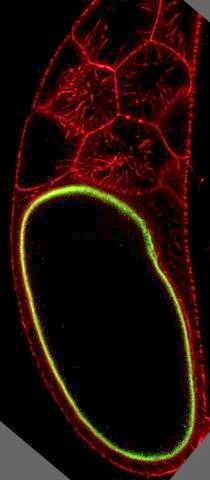
Edwin C. Stephenson
Professor Emeritus
Research Interests
 The localization of messenger RNA molecules is a widespread and important mechanism for establishing asymmetry in eggs and somatic cells. In the fruit fly Drosophila, the anterior-posterior axis of the egg and embryo are specified by the localization of mRNA and protein molecules at the anterior and posterior tips of the egg. At the anterior tip of the egg, the localized molecule with the most significant role in development is bicoid mRNA. Bicoid mRNA is localized at the anterior margin of the oocyte during oogenesis, and following fertilization, the bicoid protein is confined to the anterior embryo, where it specifies embryonic structures in a concentration-dependent manner.
A long-term interest of my lab has been to determine the role of the swallow gene in RNA localization. Females homozygous for swallow mutations fail to localize bicoid mRNA and another anterior mRNA, htsN4.
Several pieces of evidence suggest that the role of the swallow protein is to organize or stabilize the microtubules to which bicoid mRNA is attached, perhaps by anchoring this population of microtubules within the cortical cytoskeleton. We have determined the position of swallow protein by several methods: swallow protein is present at all positions at the oocyte cortex, with enrichment at the anterior oocyte margin during stages when bicoid and htsN4 mRNA localization is most active. Although swallow participates in a ubiquitous and conserved process, cytoskeletal function, in which proteins are typically very well-conserved, the swallow protein itself is extremely variable in sequence among different species of Drosophila, suggesting little selection on much of its sequence. We are currently trying to understand some of the functional and evolutionary constraints by assaying the function of deleted swallow constructs made in vitro.
Drosophila and other higher Diptera are unusual among the insects in having two distinct embryonic organizing centers, an anterior-determining system (bicoid), and a posterior-determining system (nanos et al.). The posterior organizing center is evolutionarily ancient, but the anterior center appears to be a recent evolutionary innovation. Swallow and the remainder of the localization machinery must also be of recent origin, or co-opted from some other purpose(s). We are interested in understanding how the complex mechanism of RNA localization evolved in the Diptera. The swallow gene seems to have evolved at an extremely rapid rate and shows several other interesting evolutionary quirks which we are currently examining.
The localization of messenger RNA molecules is a widespread and important mechanism for establishing asymmetry in eggs and somatic cells. In the fruit fly Drosophila, the anterior-posterior axis of the egg and embryo are specified by the localization of mRNA and protein molecules at the anterior and posterior tips of the egg. At the anterior tip of the egg, the localized molecule with the most significant role in development is bicoid mRNA. Bicoid mRNA is localized at the anterior margin of the oocyte during oogenesis, and following fertilization, the bicoid protein is confined to the anterior embryo, where it specifies embryonic structures in a concentration-dependent manner.
A long-term interest of my lab has been to determine the role of the swallow gene in RNA localization. Females homozygous for swallow mutations fail to localize bicoid mRNA and another anterior mRNA, htsN4.
Several pieces of evidence suggest that the role of the swallow protein is to organize or stabilize the microtubules to which bicoid mRNA is attached, perhaps by anchoring this population of microtubules within the cortical cytoskeleton. We have determined the position of swallow protein by several methods: swallow protein is present at all positions at the oocyte cortex, with enrichment at the anterior oocyte margin during stages when bicoid and htsN4 mRNA localization is most active. Although swallow participates in a ubiquitous and conserved process, cytoskeletal function, in which proteins are typically very well-conserved, the swallow protein itself is extremely variable in sequence among different species of Drosophila, suggesting little selection on much of its sequence. We are currently trying to understand some of the functional and evolutionary constraints by assaying the function of deleted swallow constructs made in vitro.
Drosophila and other higher Diptera are unusual among the insects in having two distinct embryonic organizing centers, an anterior-determining system (bicoid), and a posterior-determining system (nanos et al.). The posterior organizing center is evolutionarily ancient, but the anterior center appears to be a recent evolutionary innovation. Swallow and the remainder of the localization machinery must also be of recent origin, or co-opted from some other purpose(s). We are interested in understanding how the complex mechanism of RNA localization evolved in the Diptera. The swallow gene seems to have evolved at an extremely rapid rate and shows several other interesting evolutionary quirks which we are currently examining. Selected Publications
- Stephenson, E.C. 2004. Localization of swallow-green fluorescent protein in Drosophilaoogenesis and implications for the role of swallow in RNA localization. Genesis 39: 280-287.
- Pokrywka, N.J., L. Meng, K. Debiec and E.C. Stephenson. 2004. Identification of hypomorphic and null alleles of swallow via molecular and phenotypic analyses. Dev. Genes Evol. 214: 185-192.
- Meng, J. and E.C. Stephenson. 2002. Oocyte and embryonic cytoskeletal defects caused by mutations in the Drososphila swallow gene. Dev Genes Evol 212: 239-247.
- Huang, Z., N.J. Pokrywka, J.H. Yoder and E.C. Stephenson (2000) Analysis of a swallowhomologue from Drosophila pseudoobscura. Dev. Genes Evol. 210: 157-161.
- Petrov, D.A., Y.-C. Chao, E.C. Stephenson and D.L. Hartl (1998) High rate of DNA loss in aDrosophila pseudogene. Molecular Biology and Evolution 15: 1562-1567.
- Stephenson, E. C. 1995. Cytoskeletal mechanisms of RNA localization during Drosophilaoogenesis, in Localized RNAs, H. Lipshitz, ed. R. G. Landes Company, Austin.
- Pokrywka, N. J., and E. C. Stephenson. 1995. Microtubules are a general component of mRNA localization systems in Drosophila oocytes. Dev. Biol. 176: 363-370.
- Pokrywka, N. J., and E. C. Stephenson. 1994. Localized RNAs are enriched in cytoskeletal extracts of Drosophila oocytes. Dev. Biol. 166: 210-219.
- Pokrywka, N. J. and E. C. Stephenson. 1991. Microtubules mediate the localization of bicoid RNA during Drosophila oogenesis. Development 113: 55- 66.